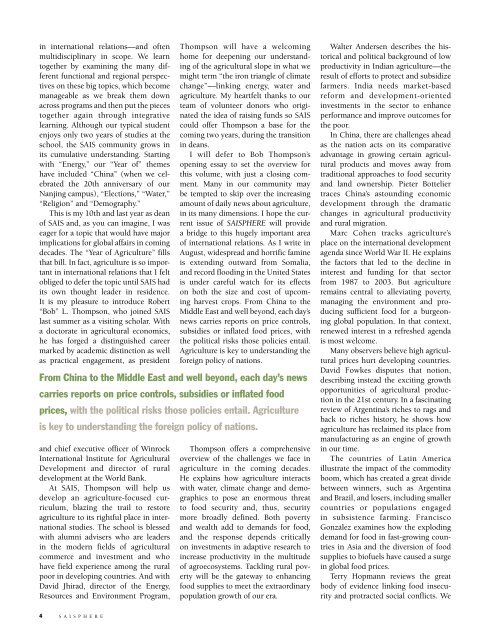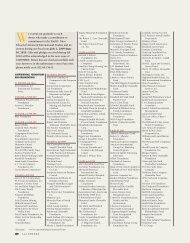Download Current Issue - SAIS
Download Current Issue - SAIS
Download Current Issue - SAIS
You also want an ePaper? Increase the reach of your titles
YUMPU automatically turns print PDFs into web optimized ePapers that Google loves.
in international relations—and often<br />
multidisciplinary in scope. We learn<br />
together by examining the many different<br />
functional and regional perspectives<br />
on these big topics, which become<br />
manageable as we break them down<br />
across programs and then put the pieces<br />
together again through integrative<br />
learning. Although our typical student<br />
enjoys only two years of studies at the<br />
school, the <strong>SAIS</strong> community grows in<br />
its cumulative understanding. Starting<br />
with “Energy,” our “Year of” themes<br />
have included “China” (when we celebrated<br />
the 20th anniversary of our<br />
Nanjing campus), “Elections,” “Water,”<br />
“Religion” and “Demography.”<br />
This is my 10th and last year as dean<br />
of <strong>SAIS</strong> and, as you can imagine, I was<br />
eager for a topic that would have major<br />
implications for global affairs in coming<br />
decades. The “Year of Agriculture” fills<br />
that bill. In fact, agriculture is so important<br />
in international relations that I felt<br />
obliged to defer the topic until <strong>SAIS</strong> had<br />
its own thought leader in residence.<br />
It is my pleasure to introduce Robert<br />
“Bob” L. Thompson, who joined <strong>SAIS</strong><br />
last summer as a visiting scholar. With<br />
a doctorate in agricultural economics,<br />
he has forged a distinguished career<br />
marked by academic distinction as well<br />
as practical engagement, as president<br />
and chief executive officer of Winrock<br />
International Institute for Agricultural<br />
Development and director of rural<br />
development at the World Bank.<br />
At <strong>SAIS</strong>, Thompson will help us<br />
develop an agriculture-focused curriculum,<br />
blazing the trail to restore<br />
agriculture to its rightful place in international<br />
studies. The school is blessed<br />
with alumni advisers who are leaders<br />
in the modern fields of agricultural<br />
commerce and investment and who<br />
have field experience among the rural<br />
poor in developing countries. And with<br />
David Jhirad, director of the Energy,<br />
Resources and Environment Program,<br />
4 <strong>SAIS</strong>PHERE<br />
Thompson will have a welcoming<br />
home for deepening our understanding<br />
of the agricultural slope in what we<br />
might term “the iron triangle of climate<br />
change”—linking energy, water and<br />
agriculture. My heartfelt thanks to our<br />
team of volunteer donors who originated<br />
the idea of raising funds so <strong>SAIS</strong><br />
could offer Thompson a base for the<br />
coming two years, during the transition<br />
in deans.<br />
I will defer to Bob Thompson’s<br />
opening essay to set the overview for<br />
this volume, with just a closing comment.<br />
Many in our community may<br />
be tempted to skip over the increasing<br />
amount of daily news about agriculture,<br />
in its many dimensions. I hope the current<br />
issue of <strong>SAIS</strong>PHERE will provide<br />
a bridge to this hugely important area<br />
of international relations. As I write in<br />
August, widespread and horrific famine<br />
is extending outward from Somalia,<br />
and record flooding in the United States<br />
is under careful watch for its effects<br />
on both the size and cost of upcoming<br />
harvest crops. From China to the<br />
Middle East and well beyond, each day’s<br />
news carries reports on price controls,<br />
subsidies or inflated food prices, with<br />
the political risks those policies entail.<br />
Agriculture is key to understanding the<br />
foreign policy of nations.<br />
From China to the Middle East and well beyond, each day’s news<br />
carries reports on price controls, subsidies or inflated food<br />
prices, with the political risks those policies entail. Agriculture<br />
is key to understanding the foreign policy of nations.<br />
Thompson offers a comprehensive<br />
overview of the challenges we face in<br />
agriculture in the coming decades.<br />
He explains how agriculture interacts<br />
with water, climate change and demographics<br />
to pose an enormous threat<br />
to food security and, thus, security<br />
more broadly defined. Both poverty<br />
and wealth add to demands for food,<br />
and the response depends critically<br />
on investments in adaptive research to<br />
increase productivity in the multitude<br />
of agroecosystems. Tackling rural poverty<br />
will be the gateway to enhancing<br />
food supplies to meet the extraordinary<br />
population growth of our era.<br />
Walter Andersen describes the historical<br />
and political background of low<br />
productivity in Indian agriculture—the<br />
result of efforts to protect and subsidize<br />
farmers. India needs market-based<br />
reform and development-oriented<br />
investments in the sector to enhance<br />
performance and improve outcomes for<br />
the poor.<br />
In China, there are challenges ahead<br />
as the nation acts on its comparative<br />
advantage in growing certain agricultural<br />
products and moves away from<br />
traditional approaches to food security<br />
and land ownership. Pieter Bottelier<br />
traces China’s astounding economic<br />
development through the dramatic<br />
changes in agricultural productivity<br />
and rural migration.<br />
Marc Cohen tracks agriculture’s<br />
place on the international development<br />
agenda since World War II. He explains<br />
the factors that led to the decline in<br />
interest and funding for that sector<br />
from 1987 to 2003. But agriculture<br />
remains central to alleviating poverty,<br />
managing the environment and producing<br />
sufficient food for a burgeoning<br />
global population. In that context,<br />
renewed interest in a refreshed agenda<br />
is most welcome.<br />
Many observers believe high agricultural<br />
prices hurt developing countries.<br />
David Fowkes disputes that notion,<br />
describing instead the exciting growth<br />
opportunities of agricultural production<br />
in the 21st century. In a fascinating<br />
review of Argentina’s riches to rags and<br />
back to riches history, he shows how<br />
agriculture has reclaimed its place from<br />
manufacturing as an engine of growth<br />
in our time.<br />
The countries of Latin America<br />
illustrate the impact of the commodity<br />
boom, which has created a great divide<br />
between winners, such as Argentina<br />
and Brazil, and losers, including smaller<br />
countries or populations engaged<br />
in subsistence farming. Francisco<br />
González examines how the exploding<br />
demand for food in fast-growing countries<br />
in Asia and the diversion of food<br />
supplies to biofuels have caused a surge<br />
in global food prices.<br />
Terry Hopmann reviews the great<br />
body of evidence linking food insecurity<br />
and protracted social conflicts. We



